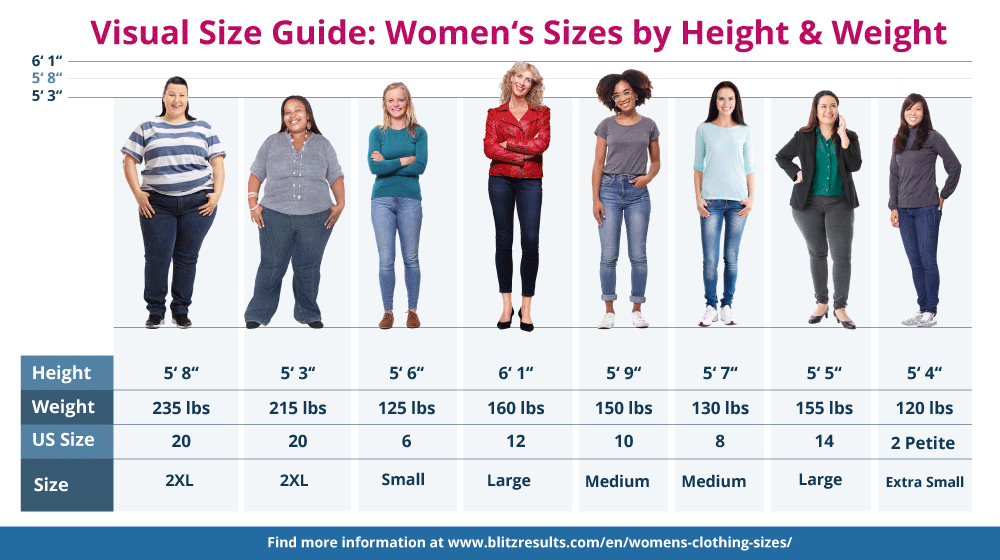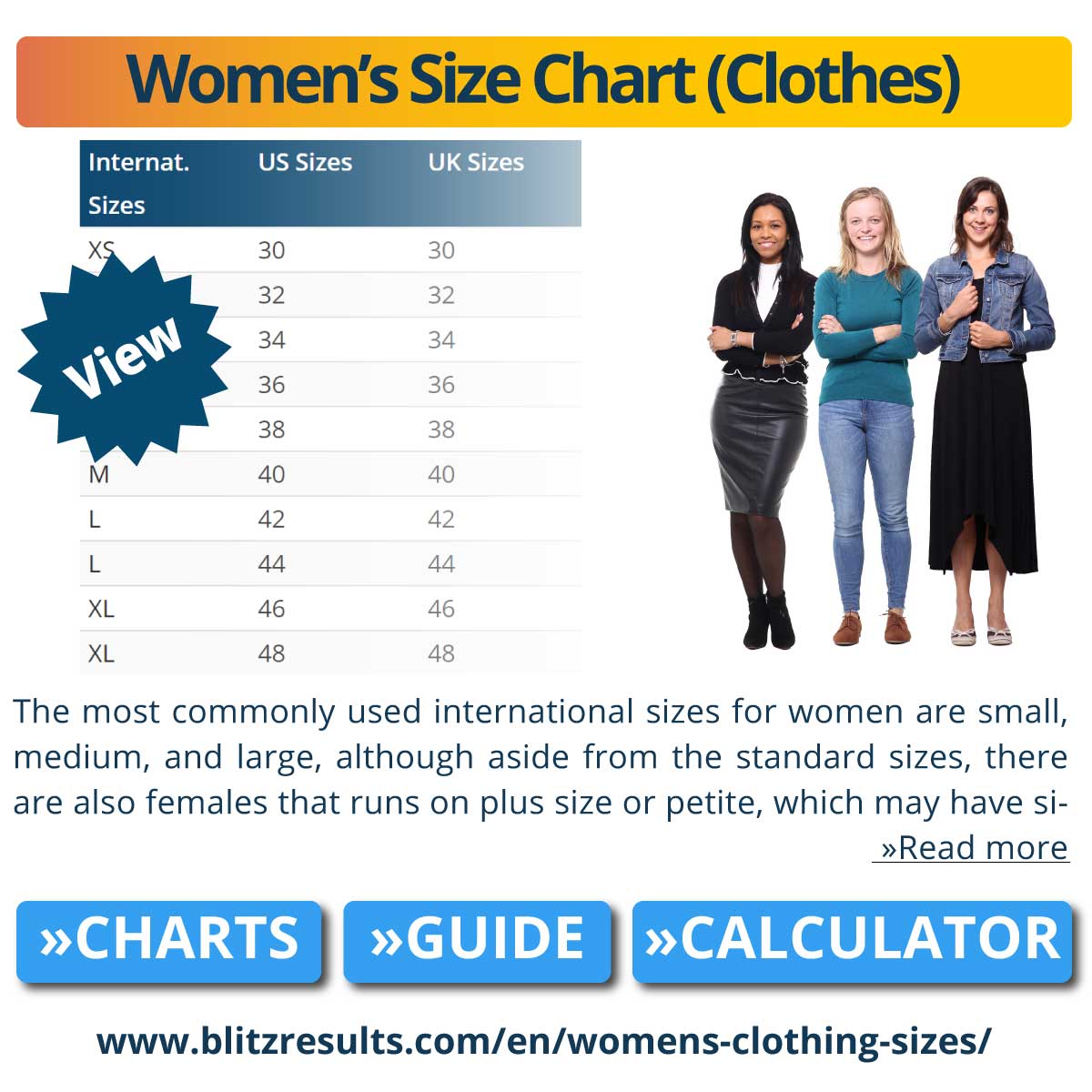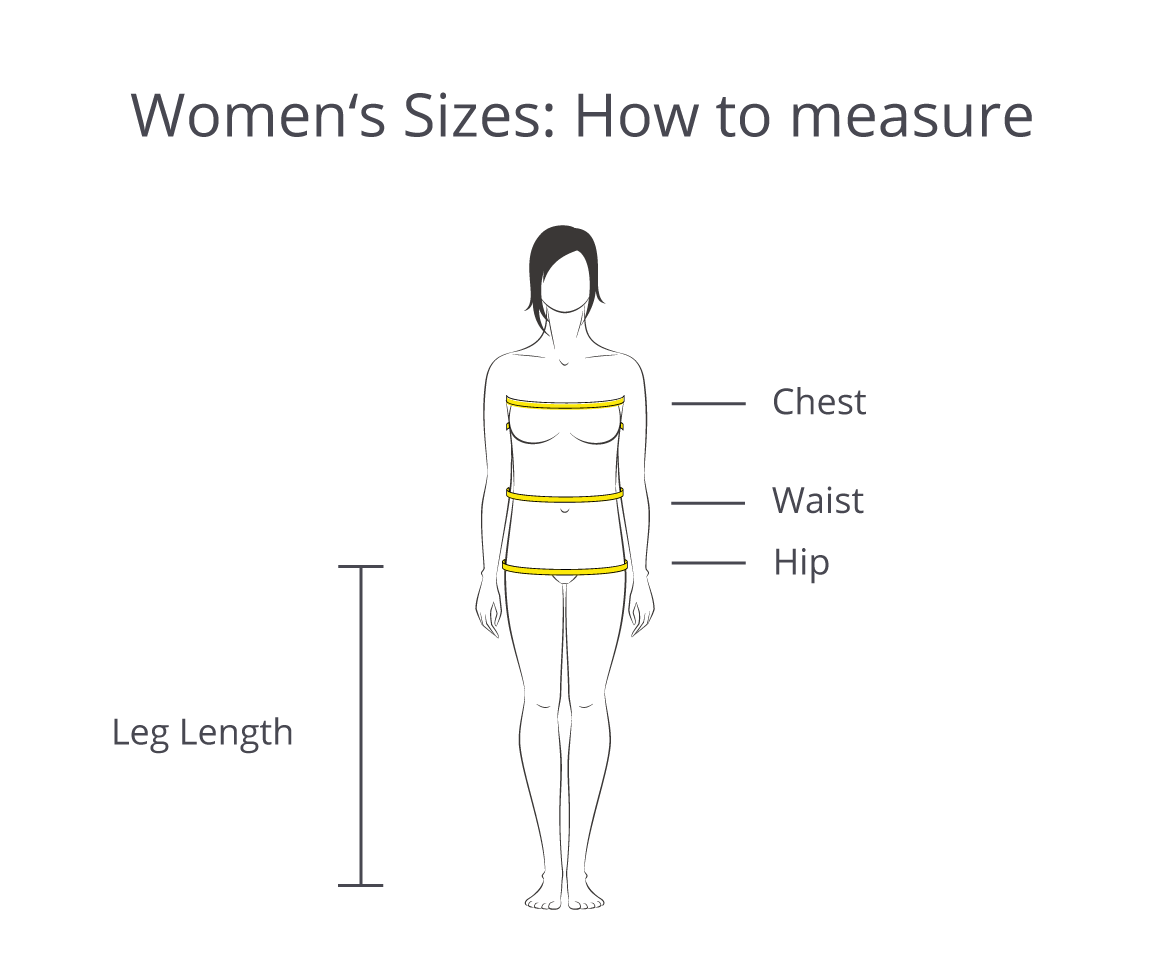Find the right size and convert measurements to clothing sizes! Quick and comprehensive guide for Women’s Size Chart Conversion to all clothing items.
Women’s Sizes: Quick and Easy
- To determine a woman’s clothing size, you need to take measurements of the following body parts or areas: chest, waist, hips and height.
- You’ll need a cloth tape measure for these measurements. Make sure it is flat against your body and not twisted or bundled up. It’s best to take these measurements while you are wearing thin, tight clothing or even no clothing to get the most accurate measurements.
- Women’s sizes are far more diverse than that for men and children. Aside from standard sizes, there are clothes labeled according to body type such as petite, curvy, plus sizes and tall.
Easy sizing guide – size by height and weight

Welcome to our visual sizing guide! To find your clothing size, simply compare your body type and height to our selection of images, each representing a standard size from XS to XL. Identify the image that closely resembles you, and that’s your estimated clothing size. Please keep in mind that this is a general estimate and individual body proportions can vary. For exact sizes please refer to the sizing chart below.
Women’s Size Chart (Clothes)

Use this chart to check what a Size 10 Women or a Size 8 Women corresponds to. How to read this table? Take your measurements – around the fullest part of your chest (bust), around your natural waistline (waist), and around the fullest part of your hips (hips). Once you have your measurements, you can compare them with the numbers in the table. Find the row where your measurements fit for bust, waist, and hips. That’s your size. Remember, these are just guidelines, and actual fit can vary by brand and style. For example, if your measurements were 36-inch bust, 28-inch waist, and 38-inch hips, you’d fall into the “M” or medium size and US Womens Size 8.
| Size | US Women's Size | Bust in Inches | Waist in Inches | Hips in Inches |
|---|---|---|---|---|
| XS | 0 | 32 | 24 | 34.5 |
| XS | 2 | 33 | 25 | 35.5 |
| S | 4 | 34 | 26 | 36.5 |
| S | 6 | 35 | 27 | 37.5 |
| M | 8 | 36 | 28 | 38.5 |
| M | 10 | 37 | 29 | 39.5 |
| L | 12 | 38.5 | 30. 5 | 41 |
| L | 14 | 40 | 32 | 42.5 |
| XL | 16 | 41.5 | 33.5 | 44 |
| XL | 18 | 43 | 35 | 45.5 |
- Clothing Size Chart for 👖 Jeans and Pants
- 👢 Womens Shoe Sizes
- Plus Sizes
- Petite Size
- International Conversion Size Chart (Euro to US, UK etc.)
Women’s Plus Sizes (Clothes)
Women’s plus sizes, designated by ‘W’ (wide) or X (Extra) starting from 12, are larger than standard sizes, designed for fuller figures. The key difference between XL and 1X is their cut. XL, a larger regular size, typically fits a 40-42 inch bust and follows regular proportions. In contrast, 1X is a plus size fitting a 42-44 inch bust, with adjustments for wider areas like armholes and waist.
| Women's Plus Alpha Size | US Women's Plus Size | Bust in Inches | Waist in Inches | Hips in Inches |
|---|---|---|---|---|
| 0X | 12W | 40 | 33 | 42 |
| 1X | 14W | 42 | 35 | 44 |
| 1X | 16W | 44 | 37 | 46 |
| 2X | 18W | 46 | 39 | 48 |
| 2X | 20W | 48 | 41 | 50 |
| 3X | 22W | 50 | 43 | 52 |
| 3X | 24W | 52 | 45 | 54 |
| 4X | 26W | 54 | 47 | 56 |
| 4X | 28W | 56 | 49 | 58 |
| 5X | 30W | 58 | 51 | 60 |
| 5X | 32W | 60 | 53 | 62 |
Women’s Petites Sizes (Clothes)
Petite sizes, designed for women 5’4″ and under, have different proportions such as shorter lengths and higher waist placement. They range from P/XS to P/XL and align with standard sizes but with adjustments for shorter statures. Numerically, a petite size 2 (2P) is similar to a standard size 2 but shorter in length. Check brand size charts for precise fits.
| Women's Petite Alpha Size | US Women's Petite Size | Bust in Inches | Waist in Inches | Hips in Inches |
|---|---|---|---|---|
| XS | 2P | 32 | 23. 5 | 34 |
| S | 4P | 33 | 24. 5 | 35 |
| S | 6P | 34 | 25. 5 | 36 |
| M | 8P | 35 | 26.5 | 37 |
| M | 10P | 36 | 27.5 | 38 |
| L | 12P | 37.5 | 29 | 39.5 |
| L | 14P | 39 | 30.5 | 41 |
Women’s Size Chart Conversion – International Sizes – EU, UK, US etc
The chart illustrates international women’s clothing size conversions. For example, a US size 0 is equivalent to a UK size 4, an EU size 30, a French size 32, and an Italian size 36. To convert from EU to US sizes, simply do the reverse. Find your Euro size in the “Womens’ EU Size” column, then look across the same row to find the corresponding US size. For example, if your EU size is EU40, your US size would be a 10 (M on the international scale).
| International Women's Size | US Women's Size | EU Size Women's | UK Size Women's | French Size Women's | Italian Women's Size |
|---|---|---|---|---|---|
| XS | 0 | 30 | 4 | 32 | 36 |
| XS | 2 | 32 | 6 | 34 | 38 |
| XS | 4 | 34 | 8 | 36 | 40 |
| S | 6 | 36 | 10 | 38 | 42 |
| S | 8 | 38 | 12 | 40 | 44 |
| M | 10 | 40 | 14 | 42 | 46 |
| M | 12 | 42 | 16 | 44 | 48 |
| L | 14 | 44 | 18 | 46 | 50 |
| L | 16 | 46 | 20 | 48 | 52 |
| XL | 18 | 48 | 22 | 50 | 54 |
| XL | 20 | 50 | 24 | 52 | 56 |
| XXL | 22 | 52 | 26 | 54 | 58 |
| XXL | 24 | 54 | 28 | 56 | 60 |
Women’s Belt Size Chart
| General Belt Size | Numerical Belt Size | Waist Measurement (inches) | Length of Belt (inches) |
|---|---|---|---|
| XS/Petite | 28 | Up to 26 | Up to 28 |
| S | 28-30 | 26-28 | 28-30 |
| M | 31-32 | 28-30 | 31-32 |
| L | 33-35 | 31-33 | 33-35 |
| XL | 36-37 | 34-35 | 36-37 |
| 2X | 38-39 | 36-37 | 38-39 |
| 3X | 40-42 | 38-39 | 40-41 |
How to Measure Womens’ Sizes
Find our detailed how to measure inseam and how to measure waist size here.

- Waist: Place the tape measure around the narrowest part of your waist, usually around your belly button or a little above it, and measure the waist circumference in inches or centimeters.
- Hip/Low Waist: Locate the point between your hip and your waist and place the tape measure around it.
- Hips/Second Hip: Following the guide for chest measurement, make sure the tape measure is wrapped around the widest area of your hip. No need to add room for movement if you are trying to buy stretchable jeans with a close or slim fit.
- Chest: Stand straight, with arms relaxed on your side, ask any adult at home to help you wrap the tape measure around the fullest part of your chest area. Allow a little room for movement, maximum of 1 inch. If you are buying a jacket, use this measurement and add a few inches depending on how loose you want the jacket to fit you.
- Height: Measure from your head to toe without any footwear on. You can use a door frame as a measuring point, stand up straight against it and make sure to properly mark the highest point of your head.
How to Find Your Size
- Sizing standards: While there are general guidelines for women’s clothing sizes, there is no universal standard that all brands follow. Don’t hesitate to reach out to the brand or retailer for help. Many have customer service teams who can assist with sizing questions.
- Technology advancements: Technology is also playing a big role in improving the sizing experience for women. For example, virtual fitting rooms and online calculators can help women determine their size and find the best fit.
- Read reviews: Check online reviews from other customers to see what they have to say about the fit of the garment. This can be a helpful way to gauge whether the clothes run true to size or not.

What size is a US size 4?
A woman’s size S in the US corresponds to a size 4, designed to fit a bust of 34 inches, a waist of 26 inches, and hips of 36.5 inches. For more precise measurements, please consult the size chart.
What size is a US size 6?
This corresponds to a woman’s size S, ideally suited for a bust of 35 inches, a waist of 27 inches, and hips of 37.5 inches. More details can be found in the provided size chart.
What size is a US size 8?
A woman’s size M in the US corresponds to a size 8, perfect for a bust of 36 inches, a waist of 28 inches, and hips measuring 38.5 inches. Check the size chart for a complete guide.
What size is a US size 10?
This falls under a woman’s size M, fitting a bust of 37 inches, a waist of 29 inches, and hips of 39.5 inches. The size chart can provide you with additional clarity.
What size is a US size 12?
In the US, a woman’s size L corresponds to a size 12, accommodating a bust of 38.5 inches, a waist of 30.5 inches, and hips of 41 inches. Please refer to the size chart for further details.
What size is a US size 16?
A woman’s size XL in the US corresponds to a size 16, designed to fit a bust of 41.5 inches, a waist of 33.5 inches, and hips of 44 inches. More sizing information can be found on the size chart.
Sizing Standards: ISO and ASTM
The International Organization for Standardization (ISO) is a well-recognized non-governmental entity that is renowned for establishing and publishing various standards. However, it does not set a specific standard for women’s clothing sizes. This absence of a universal standard in the fashion industry has led to the existence of diverse size measurement systems across various brands and countries, posing a significant challenge for consumers when determining the appropriate size to purchase.
In response to this issue, several initiatives have been launched to enhance size consistency, including the notable SizeUSA project. This particular endeavor involved gathering data from a large cross-section of women within the United States and using these measurements to formulate a comprehensive size chart.
The SizeUSA findings were then evaluated and contrasted with the ASTM D558511 (2011) standard, a guide that outlines size measurement and labeling for women’s clothing within the United States. The evaluation revealed that the SizeUSA data corresponded closely with the ASTM standard. This suggests that the SizeUSA size chart could potentially serve as a valuable resource in the quest to achieve greater size consistency across the fashion industry.
- 1 Women’s Sizes: Quick and Easy
- 2 Easy sizing guide – size by height and weight
- 3 Women’s Size Chart (Clothes)
- 4 Women’s Plus Sizes (Clothes)
- 5 Women’s Petites Sizes (Clothes)
- 6 Women’s Size Chart Conversion – International Sizes – EU, UK, US etc
- 7 Women’s Belt Size Chart
- 8 How to Measure Womens’ Sizes
- 9 How to Find Your Size
